In early 2010, we knew we had an exhaust leak. Also, the shiny metallic coating on our exhaust wrap in the engine room was starting to disintegrate, regularly shedding small silver fragments all over the engine room.
Eric knew getting the exhaust wrap off to look for the leak would be be messy, since it was falling apart. Getting it back on would be difficult and even messier. We decided it was time to replace the wrap, and hired a professional to remove the old wrap, measure and fabricate new wrap, and install it. While the wrap was off, Eric could inspect the system and make the repair.
Rather than get the same thing, we upgraded to a higher quality product. The outer coating looks like fabric (but is apparently made with silicone), doesn’t ever flake, and can be cleaned by gently wiping it a cloth and Simple Green. It is also easier to take on and off because it is held together by springs and hooks instead of wires.
Exhaust wraps are custom made to fit each boat. We chose a company called SOS to fabricate and install ours. We only had them do the pieces in the engine room since the wrap in the smoke stack was still in good shape.
Chris from SOS came out to take measurements. When he removed our existing exhaust wrap, he noticed there was a significant amount of carbon build-up underneath one the flange wraps, so we now knew the general location of the leak. Here are a few shots of our “naked” exhaust.
Eric assumed that the leak was coming from the closest gasket, the one on the elbow. Eric replaced the gasket before Chris came back to install the new wrap.
The new wrap fit great and looked good. (These photos were taken today, so Eric has taken the wrap on and off numerous times since it was installed in 2010. Eric wants to make it clear he did kind of a sloppy job of putting it back on last time; normally it fits together a little bit nicer.)
The next time we ran the boat, Eric was frustrated to find that the exhaust was still leaking. Eric continued to work on by changing each gasket one by one, but even with all new gaskets, the leak was still there.
Baffled as to why there was still a leak, he wondered if maybe the ceramic gaskets weren’t sealing properly. He changed all the gaskets to graphite, a more flexible material that would seal better and wouldn’t become brittle as it deteriorated like ceramic would. Ceramic could take temperatures up to 1400 degrees Fahrenheit and graphite could only go up to 1200 degrees, but the temperature difference was not an issue since we’ve never seen our exhaust temperature go above 800 degrees. But even with the graphite gaskets, the leak was still there.
In the autumn (2010), Eric was again examining the exhaust when he noticed a tiny hole in the wrinkle belly. It was in a hard to see place between the folds. He thought it was a miracle he spotted it at all. Ah ha! Mystery solved! He put some JW Weld (glue that can take really high heat) on it and we went out for a test ride. At first, all seemed fine. Eric was elated–the exhaust leak was fixed! Hooray! Then, as he customarily does before shutting off the engine, he ran the boat at 2200 RPM for a few minutes to clear out any soot from the stack. The higher RPMs caused the glue to crack. So much for JW Weld!
In November 2010, we took Kosmos to Nordhavn in Dana Point to have a whole slew of maintenance work done (hopefully, we’ll get into more of the work they did in future posts). One of the things they did for us was weld the wrinkle belly, which fixed the leak. We’ve had no further exhaust issues since then.
In September 2011, we took Kosmos up to San Francisco. On the ride up, Eric noticed a weird dust around the engine. It definitely wasn’t exhaust soot. We had a hard time getting the dust out of the carpet when we vacuumed, so it wasn’t ordinary dirt, either. At first he thought it was from the main engine serpentine belt. The belt had been recently changed and Eric thought either the belt itself was defective or it was somehow installed wrong and chaffing. He watched the belt carefully, and after a while it was clear the belt was perfect and that the dust was coming from somewhere else.
We noticed the dust again when we brought Kosmos back to San Diego at the end of October 2011. Eric still couldn’t figure out where it was coming from.
When we went to Catalina in May of this year (2012), we again noticed the dust, along with some silver flecks. We knew the silver flecks were from the exhaust wrap in the smoke stack and that it was time to replace the wrap up there. We assumed that the dust must have also come from the disintegrating wrap.
We’ve been happy with the insulation in the engine room, so we called Chris from SOS back to do the stack wrap. Unfortunately, we found out that there are parts of the stack that are completely inaccessible, so not all of it could be easily replaced. But Chris did as much as he could.
After Chris unwrapped the muffler to measure it, he called Eric over to have a look. Eric was shocked to see the muffler was totally rusty! Argh! At least now we knew where the mystery dust was coming from!
Eric knew the muffler was made of carbon steel and that other Nordhavns had experienced rust issues with the muffler, but we didn’t think it would happen to us, at least not this soon. For some reason, we thought the wrap protected the muffler from rust, but obviously, it didn’t. Later, another Nordhavn owner told us the wrapping actually accelerates the rust since it holds moisture in.
The metal was thick, so it would be a long time before it rusted through (based on what a mechanic later told us, it probably had three years of life left). Mechanically speaking, there was no need to replace it. We have heard of people who regularly scrape rust off their mufflers as part of their standard boat maintenance.
Eric insisted we change the muffler right away. First of all, unwrapping the muffler and physically scraping it was a tedious and messy job that neither of us wanted to do. Plus, rust was a hazard for the baby, and the rust particles in the engine room and around the smoke stack on deck would only get worse. Eric said that if we did it now, it would be a relatively simple job. If waited too long it could cause a leak at an unexpected time — and all boaters know that leaks always come at the worst possible time. Plus, if we waited, the bolts would be even more rusted and difficult to take off.
Eric started looking into mufflers…. to be continued in another post.

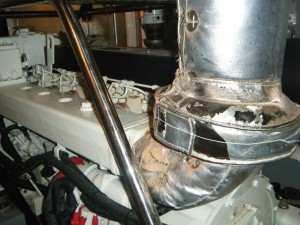
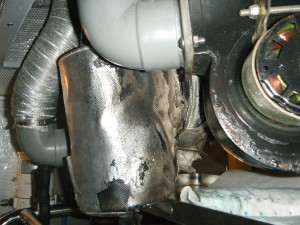
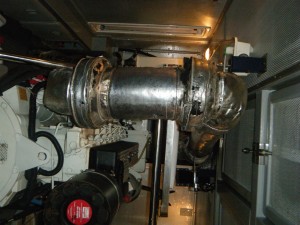
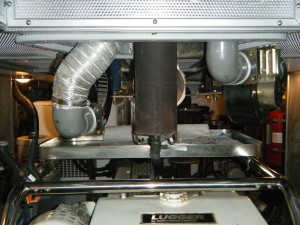
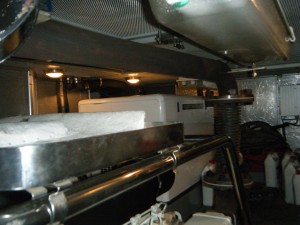
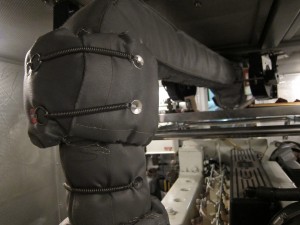
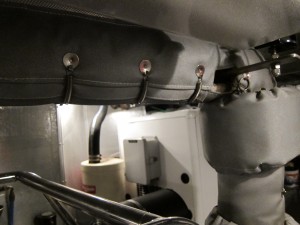

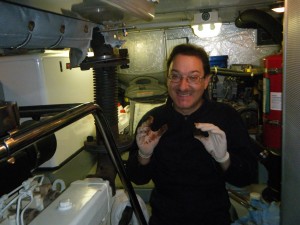
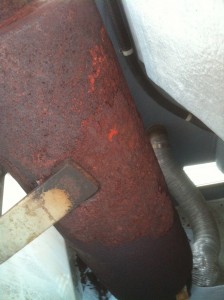

7/4/2013 ERIC, INJOYED YOUR POST ON LEAKS AND EXHAUST WRAP.DO YOU HAVE ANY KIND OF AN ALARM SYSTEM THAT WILL
ALEART YOU LIKE A CARBONDIOXID DETECTOR ? THIS POST
GAVE ME A WAKE UP CALL TO CHECK MY BOAT.
LOOKING FORWARD TO ANOTHER POST, LIKE OTHER MAINTENCE
PROJECTS OR HOW YOU USE YOUR NAVIGATIONAL INSTRIMENTS
DAVID W. FRENCH
Hi David. We do have a carbon monoxide detector aboard. It is in the mid stateroom. Actually good time to check the batteries on it, as well check any expiration dates. Those detectors do not last forever.